- Joined
- Oct 9, 2007
- Messages
- 47,430 (7.51/day)
- Location
- Hyderabad, India
| System Name | RBMK-1000 |
|---|---|
| Processor | AMD Ryzen 7 5700G |
| Motherboard | ASUS ROG Strix B450-E Gaming |
| Cooling | DeepCool Gammax L240 V2 |
| Memory | 2x 8GB G.Skill Sniper X |
| Video Card(s) | Palit GeForce RTX 2080 SUPER GameRock |
| Storage | Western Digital Black NVMe 512GB |
| Display(s) | BenQ 1440p 60 Hz 27-inch |
| Case | Corsair Carbide 100R |
| Audio Device(s) | ASUS SupremeFX S1220A |
| Power Supply | Cooler Master MWE Gold 650W |
| Mouse | ASUS ROG Strix Impact |
| Keyboard | Gamdias Hermes E2 |
| Software | Windows 11 Pro |
AMD today announced its Radeon Pro VII professional graphics card targeting 3D artists, engineering professionals, broadcast media professionals, and HPC researchers. The card is based on AMD's "Vega 20" multi-chip module that incorporates a 7 nm (TSMC N7) GPU die, along with a 4096-bit wide HBM2 memory interface, and four memory stacks adding up to 16 GB of video memory. The GPU die is configured with 3,840 stream processors across 60 compute units, 240 TMUs, and 64 ROPs. The card is built in a workstation-optimized add-on card form-factor (rear-facing power connectors and lateral-blower cooling solution).
What separates the Radeon Pro VII from last year's Radeon VII is full double precision floating point support, which is 1:2 FP32 throughput compared to the Radeon VII, which is locked to 1:4 FP32. Specifically, the Radeon Pro VII offers 6.55 TFLOPs double-precision floating point performance (vs. 3.36 TFLOPs on the Radeon VII). Another major difference is the physical Infinity Fabric bridge interface, which lets you pair up to two of these cards in a multi-GPU setup to double the memory capacity, to 32 GB. Each GPU has two Infinity Fabric links, running at 1333 MHz, with a per-direction bandwidth of 42 GB/s. This brings the total bidirectional bandwidth to a whopping 168 GB/s—more than twice the PCIe 4.0 x16 limit of 64 GB/s.

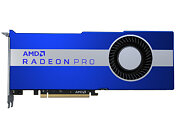

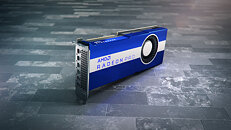

At this time only Radeon Pro Render supports combining memory, but AMD is confident that more applications will add support. Since AMD's neither mentioned "cache coherent", nor "virtual memory", it seems this is similar to DX12 multi-GPU, where applications can combine resources from multiple adapters in the system. Running Infinity Fabric Link involves using a $199 IF bridge card across two IFIS fingers on top of the card. Also, unlike the Radeon VII, AMD unlocked PCI-Express gen 4.0 support. The card features a PCI-Express 4.0 x16 host interface, which should come in handy when you use two of them on an AMD Ryzen 3000-powered workstation, where gen 4.0 x8 would let you overcome system bus bottlenecks. The card also features memory ECC.
Where the Radeon Pro VII hopes to dent NVIDIA's market-share is with pricing. The card is priced at USD $1,899 (SEP), about 20% cheaper than NVIDIA Quadro RTX 5000, and is targeting academia (universities and institutes), emerging design- and engineering firms, and HPC researchers, who may find the lower price attractive, especially when you consider that a pair of this card, along with a $200 bridge, would beat a Quadro GV100 in pricing and throughput ($8,999). AMD considers the card's main competition to be the Quadro RTX 5000, and is claiming performance gains over the NVIDIA card in several CAE, broadcast media- and HPC applications.
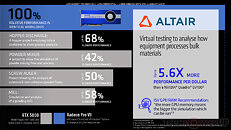


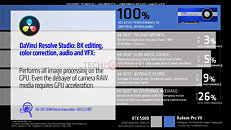
The Radeon Pro VII pulls power from a combination of 6-pin and 8-pin PCIe power connectors (compared to the dual-8-pin setup of the Radeon VII. This, combined with the fact that the FP32 throughput is slightly lower on the Radeon Pro (13.1 TFLOP/s vs. 13.4 TFLOPs), suggests that it may be clocked lower than the Radeon VII, and have a tighter power headroom. This may be an attempt by AMD to ensure the Radeon Pro VII doesn't get too close to the upcoming Radeon MI100.
Display setup includes six mini-DisplayPort 1.4 connectors, capable of 8K. AMD confirmed that the display- and media engines of the card are unchanged from "Vega 20," and not the newer "Navi" combo that's been implemented on the "Vega" iGPU of "Renoir" Ryzen processors. The card also supports genlock and framelock between multiple cards using the FirePro S400 synchronization module, handy in serious content creation workloads.
[subheading]AMD Press Release[/subheading]
AMD today announced the AMD Radeon Pro VII workstation graphics card for broadcast and engineering professionals, delivering exceptional graphics and computational performance, as well as innovative features. The new graphics card is designed to power today's most demanding broadcast and media projects, complex computer aided engineering (CAE) simulations and the development of high-performance computing (HPC) applications that enable scientific discovery on AMD-powered supercomputers.
The AMD Radeon Pro VII graphics card offers 16 GB of extreme speed HBM2 (High Bandwidth Memory), and support for 6x synchronized displays and high-bandwidth PCIe 4.0 interconnect technology. Providing up to 26 percent higher 8K image processing performance in Blackmagic Design DaVinci Resolve and up to 5.6x the double precision (FP64) performance-per-dollar versus the competition, the new graphics card introduces AMD Infinity Fabric Link technology to the workstation market. AMD Infinity Fabric Link speeds application data throughput by enabling high-speed GPU-to-GPU communications in multi-GPU system configurations.
The new workstation graphics card provides the high-performance and advanced features enabling post-production teams and broadcasters to visualize, review and interact with 8K content whether in the broadcast booth, on the studio floor or in the media server pipeline. It also enables engineers and data scientists to handle larger and more complex models and datasets, while reducing run times for engineering simulations and scientific computing workloads.
"Today's professionals are challenged to meet high pressure deadlines under increasingly tight budgets while aiming to deliver world-class results," said Scott Herkelman, corporate vice president and general manager, Graphics Business Unit at AMD. "They demand more from their graphics card, and AMD Radeon Pro VII delivers. It provides innovative, high-performance technologies that allow users to easily manage larger, more complex simulations, create and manage exceptionally high-resolution digital media and digital signage content, and develop advanced HPC applications to drive new waves of scientific discovery on large scale supercomputer deployments."
Key capabilities and features of the AMD Radeon Pro VII graphics card include:
The AMD Radeon Pro VII graphics card is expected to be available from major etailers/retailers beginning mid-June 2020 for an SEP of $1,899 USD.
[subheading]Updates to AMD Radeon Pro Render - Developer Updates and New Plugins[/subheading]
AMD Radeon ProRender is our fast, easy, and incredible physically-based rendering engine built on industry standards that can take your rendering to the next level on virtually any GPU, any CPU, and any OS1 in over a dozen leading digital content creation and CAD applications.
Ready for this week's relaunch of GPUOpen, we have some exciting new announcements and releases, including some big changes for developers looking to integrate Radeon ProRender into their applications, a preview of our next-generation rendering engine, and new and updated plug-ins for Blender, Houdini, Maya, and Unreal Engine.
Now Even Easier for Developers to Implement
AMD Radeon ProRender Developer Suite, our complete toolkit of SDKs for developers looking to add physically-based rendering to their application's workflow, has moved to a new home on GPUOpen -- relaunched this week with a brand-new website with a modern look and feel.
Along with this move, we have also made some important changes as to how we license Radeon ProRender for developers to make it even easier to work with. Our SDKs are now freely available under the permissive Apache License 2.0, simplifying the licensing agreement to use Radeon ProRender in your application.
On top of this new licensing model, we are also making open-source versions of all our Radeon ProRender plug-ins available on GPUOpen, which developers can use as examples of how to integrate our renderer into their application.
Updated SDKs, Including the Next Generation of AMD Rendering Software
The developer suite consists of three SDKs, AMD Radeon ProRender, AMD Radeon Rays, and the AMD Radeon Image Filter Library SDK, and in addition to the new home and licensing changes, we are made a few substantial updates. Firstly, a beta of the Radeon ProRender 2.0 SDK, the next generation of our rendering software, is now available.
AMD Radeon ProRender 2.0 adds several significant new features and improvements, including a new flexible shader node system, out-of-core support for heavy geometry, and improvements to our rendering algorithm designed for better convergence with the same samples per pixel. Radeon ProRender 2.0 also lets developers boost their applications' rendering performance with improved CPU + GPU rendering - for example, when tested with our internal render test with the just announced the AMD Radeon Pro VII plus the AMD Ryzen Threadripper 3990X working together, render times were up to 47 percent faster.
Lastly, we have released AMD Radeon Rays 4.0, an update to our high-performance ray intersection acceleration library. This latest version supports both AMD GPUs and CPUs as well as those of other vendors using DirectX 12 in addition to Vulkan APIs, has a custom AABB hierarchy, and includes GPU Bounding Volume Hierarchy (BVH) optimizations. Radeon Rays 2.0 is still available for developers needing OpenCL support.
New Plug-In for Unreal Engine
In addition to all the updates we have for developers, don't think we've also forgotten our users. Today we're also releasing our new Radeon ProRender plug-in for Unreal Engine which adds both our Vulkan API-based Full Spectrum Rendering technology and full OpenCL path-traced rendering to this popular application that is increasingly being used for more than just game development.
Our plug-in is fully integrated into Unreal Engine, and uses the existing lights, materials, and textures of any scene you've created - and as the Unreal's Datasmith tool makes it simple to make Unreal Engine part of product and AEC visualization workflows, designers and architects can now easily create high-quality photorealistic renderings of their creations using Radeon ProRender.
Radeon ProRender for Unreal Engine also includes many of the features you would expect from our other plug-ins, such as AI-accelerated denoising, adaptive sampling, and native tone mapping and gamma controls.
Updated Plug-Ins, Including Support for Blender 2.83
Wait, there's more - we don't just have a new plug-in but also quite a few exciting new updates to our existing plug-ins. To start, for our Blender users, we have updated our plug-in to support the upcoming 2.83 release of Blender. We are also adding an OpenVBD volumes node, improved export times for image files (when using 2.83), and support for ObjectID and MaterialID AOVs.
Our plug-in for Autodesk Maya now supports the latest version, 2020, and this update adds a ton of new and updated features, including support for Esphere's Ornatrix hair plug-in for Maya, support for rendering OpenVBD volumes, Radeon ProRender lights showing in the Maya Light Editor and HyperShade, support for more Maya shader nodes, camera motion blur, and various UI improvements.
Our newest plug-in before today's release for Unreal Engine is our plug-in for SideFX Houdini 18 that works with SideFX Solaris, Houdini's USD-based set of tools for lookdev, layout, and lighting. We have updated our plug-in to support the Houdini principled shader, improved the Radeon ProRender area lights, added motion blur support, and improved our OpenVDB volume rendering.
Try Out Our Next-Generation Rendering Engine Today
Lastly, as an extra treat for our dedicated Radeon ProRender users, we wanted to give you a sneak peek of Radeon ProRender 2.0 rendering - in our updated plug-ins for Blender and Maya you can now turn on an "experimental" Radeon ProRender 2.0 mode to preview some of the improvements our next-generation rendering engine brings to table. Keep in mind as an "experimental" feature, this mode should not be expected to be as stable as the standard rendering mode and is not recommended for use in production workflows, it's just to give you a taste of what's coming.
New and Updated Plug-Ins Available Now
Everything you've read about above is available today. Developers can visit GPUOpen to learn more about and download our latest Radeon ProRender SDKs and users can download our new and updated plug-ins from the link below.
DOWNLOAD: Updated Pro Render Plug-ins
Learn more about Pro Render here.
[subheading]Complete AMD Slide Deck[/subheading]










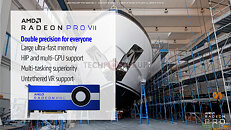
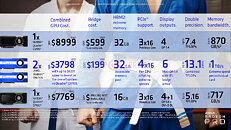













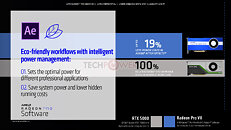

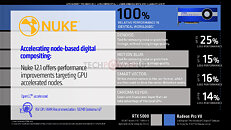

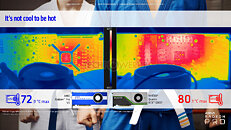



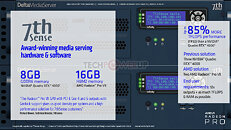


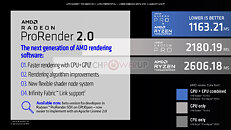




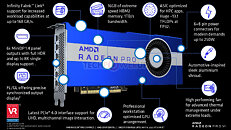

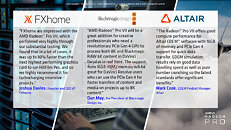




View at TechPowerUp Main Site
What separates the Radeon Pro VII from last year's Radeon VII is full double precision floating point support, which is 1:2 FP32 throughput compared to the Radeon VII, which is locked to 1:4 FP32. Specifically, the Radeon Pro VII offers 6.55 TFLOPs double-precision floating point performance (vs. 3.36 TFLOPs on the Radeon VII). Another major difference is the physical Infinity Fabric bridge interface, which lets you pair up to two of these cards in a multi-GPU setup to double the memory capacity, to 32 GB. Each GPU has two Infinity Fabric links, running at 1333 MHz, with a per-direction bandwidth of 42 GB/s. This brings the total bidirectional bandwidth to a whopping 168 GB/s—more than twice the PCIe 4.0 x16 limit of 64 GB/s.





At this time only Radeon Pro Render supports combining memory, but AMD is confident that more applications will add support. Since AMD's neither mentioned "cache coherent", nor "virtual memory", it seems this is similar to DX12 multi-GPU, where applications can combine resources from multiple adapters in the system. Running Infinity Fabric Link involves using a $199 IF bridge card across two IFIS fingers on top of the card. Also, unlike the Radeon VII, AMD unlocked PCI-Express gen 4.0 support. The card features a PCI-Express 4.0 x16 host interface, which should come in handy when you use two of them on an AMD Ryzen 3000-powered workstation, where gen 4.0 x8 would let you overcome system bus bottlenecks. The card also features memory ECC.
Where the Radeon Pro VII hopes to dent NVIDIA's market-share is with pricing. The card is priced at USD $1,899 (SEP), about 20% cheaper than NVIDIA Quadro RTX 5000, and is targeting academia (universities and institutes), emerging design- and engineering firms, and HPC researchers, who may find the lower price attractive, especially when you consider that a pair of this card, along with a $200 bridge, would beat a Quadro GV100 in pricing and throughput ($8,999). AMD considers the card's main competition to be the Quadro RTX 5000, and is claiming performance gains over the NVIDIA card in several CAE, broadcast media- and HPC applications.




The Radeon Pro VII pulls power from a combination of 6-pin and 8-pin PCIe power connectors (compared to the dual-8-pin setup of the Radeon VII. This, combined with the fact that the FP32 throughput is slightly lower on the Radeon Pro (13.1 TFLOP/s vs. 13.4 TFLOPs), suggests that it may be clocked lower than the Radeon VII, and have a tighter power headroom. This may be an attempt by AMD to ensure the Radeon Pro VII doesn't get too close to the upcoming Radeon MI100.
Display setup includes six mini-DisplayPort 1.4 connectors, capable of 8K. AMD confirmed that the display- and media engines of the card are unchanged from "Vega 20," and not the newer "Navi" combo that's been implemented on the "Vega" iGPU of "Renoir" Ryzen processors. The card also supports genlock and framelock between multiple cards using the FirePro S400 synchronization module, handy in serious content creation workloads.
[subheading]AMD Press Release[/subheading]
AMD today announced the AMD Radeon Pro VII workstation graphics card for broadcast and engineering professionals, delivering exceptional graphics and computational performance, as well as innovative features. The new graphics card is designed to power today's most demanding broadcast and media projects, complex computer aided engineering (CAE) simulations and the development of high-performance computing (HPC) applications that enable scientific discovery on AMD-powered supercomputers.
The AMD Radeon Pro VII graphics card offers 16 GB of extreme speed HBM2 (High Bandwidth Memory), and support for 6x synchronized displays and high-bandwidth PCIe 4.0 interconnect technology. Providing up to 26 percent higher 8K image processing performance in Blackmagic Design DaVinci Resolve and up to 5.6x the double precision (FP64) performance-per-dollar versus the competition, the new graphics card introduces AMD Infinity Fabric Link technology to the workstation market. AMD Infinity Fabric Link speeds application data throughput by enabling high-speed GPU-to-GPU communications in multi-GPU system configurations.
The new workstation graphics card provides the high-performance and advanced features enabling post-production teams and broadcasters to visualize, review and interact with 8K content whether in the broadcast booth, on the studio floor or in the media server pipeline. It also enables engineers and data scientists to handle larger and more complex models and datasets, while reducing run times for engineering simulations and scientific computing workloads.
"Today's professionals are challenged to meet high pressure deadlines under increasingly tight budgets while aiming to deliver world-class results," said Scott Herkelman, corporate vice president and general manager, Graphics Business Unit at AMD. "They demand more from their graphics card, and AMD Radeon Pro VII delivers. It provides innovative, high-performance technologies that allow users to easily manage larger, more complex simulations, create and manage exceptionally high-resolution digital media and digital signage content, and develop advanced HPC applications to drive new waves of scientific discovery on large scale supercomputer deployments."
Key capabilities and features of the AMD Radeon Pro VII graphics card include:
- Leading Double Precision Performance - With up to 6.5 TFLOPS (FP64) of double precision performance for demanding engineering and scientific workloads, the Radeon Pro VII graphics card provides 5.6x the performance-per-dollar versus the competition on the AMD Internal Benchmark for Altair EDEM "Screw Auger" viewset.
- High-speed Memory - 16 GB of HBM2 with 1 TB/s memory bandwidth and full ECC capability handles large and complex models and datasets smoothly with low latency.
- AMD Infinity Fabric Link - A high-bandwidth, low-latency connection that allows memory sharing between two AMD Radeon Pro VII GPUs, enabling users to increase project workload size and scale, develop more complex designs and run larger simulations to drive scientific discovery. AMD Infinity Fabric Link delivers up to 5.25x PCIe 3.0 x16 bandwidth with a communication speed of up to 168 GB/s peer-to-peer between GPUs.
- Remote Working - Users can access their physical workstation from virtually anywhere for unhindered productivity with the remote workstation IP built into AMD Radeon Pro Software for Enterprise driver.
- High-bandwidth PCIe 4.0 Support - PCIe 4.0 delivers double the bandwidth of PCIe 3.0 to enable smooth performance for 8K, multichannel image interaction.
- Frame Lock/Genlock - Enables precise synchronized output for display walls, digital signage and other visual displays (AMD FirePro S400 synchronization module required).
- High-resolution/Multi-display Support - Supports up to 6x synchronized display panels, full HDR and 8K screen resolution (single display) combined with ultra-fast encode and decode support for enhanced multi-stream workflows.
- Professional Application Certification - Optimized and certified with leading professional applications for stability and reliability. The list of Radeon Pro Software-certified ISV applications can be found here.
- ROCm Open Ecosystem - Open software platform for accelerated compute provides an easy GPU programming model with support for OpenMP, HIP, and OpenCL, as well as support for leading machine learning and HPC frameworks, including TensorFlow, PyTorch, Kokkos, and RAJA
The AMD Radeon Pro VII graphics card is expected to be available from major etailers/retailers beginning mid-June 2020 for an SEP of $1,899 USD.
[subheading]Updates to AMD Radeon Pro Render - Developer Updates and New Plugins[/subheading]
AMD Radeon ProRender is our fast, easy, and incredible physically-based rendering engine built on industry standards that can take your rendering to the next level on virtually any GPU, any CPU, and any OS1 in over a dozen leading digital content creation and CAD applications.
Ready for this week's relaunch of GPUOpen, we have some exciting new announcements and releases, including some big changes for developers looking to integrate Radeon ProRender into their applications, a preview of our next-generation rendering engine, and new and updated plug-ins for Blender, Houdini, Maya, and Unreal Engine.
Now Even Easier for Developers to Implement
AMD Radeon ProRender Developer Suite, our complete toolkit of SDKs for developers looking to add physically-based rendering to their application's workflow, has moved to a new home on GPUOpen -- relaunched this week with a brand-new website with a modern look and feel.
Along with this move, we have also made some important changes as to how we license Radeon ProRender for developers to make it even easier to work with. Our SDKs are now freely available under the permissive Apache License 2.0, simplifying the licensing agreement to use Radeon ProRender in your application.
On top of this new licensing model, we are also making open-source versions of all our Radeon ProRender plug-ins available on GPUOpen, which developers can use as examples of how to integrate our renderer into their application.
Updated SDKs, Including the Next Generation of AMD Rendering Software
The developer suite consists of three SDKs, AMD Radeon ProRender, AMD Radeon Rays, and the AMD Radeon Image Filter Library SDK, and in addition to the new home and licensing changes, we are made a few substantial updates. Firstly, a beta of the Radeon ProRender 2.0 SDK, the next generation of our rendering software, is now available.
AMD Radeon ProRender 2.0 adds several significant new features and improvements, including a new flexible shader node system, out-of-core support for heavy geometry, and improvements to our rendering algorithm designed for better convergence with the same samples per pixel. Radeon ProRender 2.0 also lets developers boost their applications' rendering performance with improved CPU + GPU rendering - for example, when tested with our internal render test with the just announced the AMD Radeon Pro VII plus the AMD Ryzen Threadripper 3990X working together, render times were up to 47 percent faster.
Lastly, we have released AMD Radeon Rays 4.0, an update to our high-performance ray intersection acceleration library. This latest version supports both AMD GPUs and CPUs as well as those of other vendors using DirectX 12 in addition to Vulkan APIs, has a custom AABB hierarchy, and includes GPU Bounding Volume Hierarchy (BVH) optimizations. Radeon Rays 2.0 is still available for developers needing OpenCL support.
New Plug-In for Unreal Engine
In addition to all the updates we have for developers, don't think we've also forgotten our users. Today we're also releasing our new Radeon ProRender plug-in for Unreal Engine which adds both our Vulkan API-based Full Spectrum Rendering technology and full OpenCL path-traced rendering to this popular application that is increasingly being used for more than just game development.
Our plug-in is fully integrated into Unreal Engine, and uses the existing lights, materials, and textures of any scene you've created - and as the Unreal's Datasmith tool makes it simple to make Unreal Engine part of product and AEC visualization workflows, designers and architects can now easily create high-quality photorealistic renderings of their creations using Radeon ProRender.
Radeon ProRender for Unreal Engine also includes many of the features you would expect from our other plug-ins, such as AI-accelerated denoising, adaptive sampling, and native tone mapping and gamma controls.
Updated Plug-Ins, Including Support for Blender 2.83
Wait, there's more - we don't just have a new plug-in but also quite a few exciting new updates to our existing plug-ins. To start, for our Blender users, we have updated our plug-in to support the upcoming 2.83 release of Blender. We are also adding an OpenVBD volumes node, improved export times for image files (when using 2.83), and support for ObjectID and MaterialID AOVs.
Our plug-in for Autodesk Maya now supports the latest version, 2020, and this update adds a ton of new and updated features, including support for Esphere's Ornatrix hair plug-in for Maya, support for rendering OpenVBD volumes, Radeon ProRender lights showing in the Maya Light Editor and HyperShade, support for more Maya shader nodes, camera motion blur, and various UI improvements.
Our newest plug-in before today's release for Unreal Engine is our plug-in for SideFX Houdini 18 that works with SideFX Solaris, Houdini's USD-based set of tools for lookdev, layout, and lighting. We have updated our plug-in to support the Houdini principled shader, improved the Radeon ProRender area lights, added motion blur support, and improved our OpenVDB volume rendering.
Try Out Our Next-Generation Rendering Engine Today
Lastly, as an extra treat for our dedicated Radeon ProRender users, we wanted to give you a sneak peek of Radeon ProRender 2.0 rendering - in our updated plug-ins for Blender and Maya you can now turn on an "experimental" Radeon ProRender 2.0 mode to preview some of the improvements our next-generation rendering engine brings to table. Keep in mind as an "experimental" feature, this mode should not be expected to be as stable as the standard rendering mode and is not recommended for use in production workflows, it's just to give you a taste of what's coming.
New and Updated Plug-Ins Available Now
Everything you've read about above is available today. Developers can visit GPUOpen to learn more about and download our latest Radeon ProRender SDKs and users can download our new and updated plug-ins from the link below.
DOWNLOAD: Updated Pro Render Plug-ins
Learn more about Pro Render here.
[subheading]Complete AMD Slide Deck[/subheading]
















































View at TechPowerUp Main Site







 EVGA also has an SLI HB bridge that really takes the cake. Maybe its a transformer, though, in secret.
EVGA also has an SLI HB bridge that really takes the cake. Maybe its a transformer, though, in secret.
